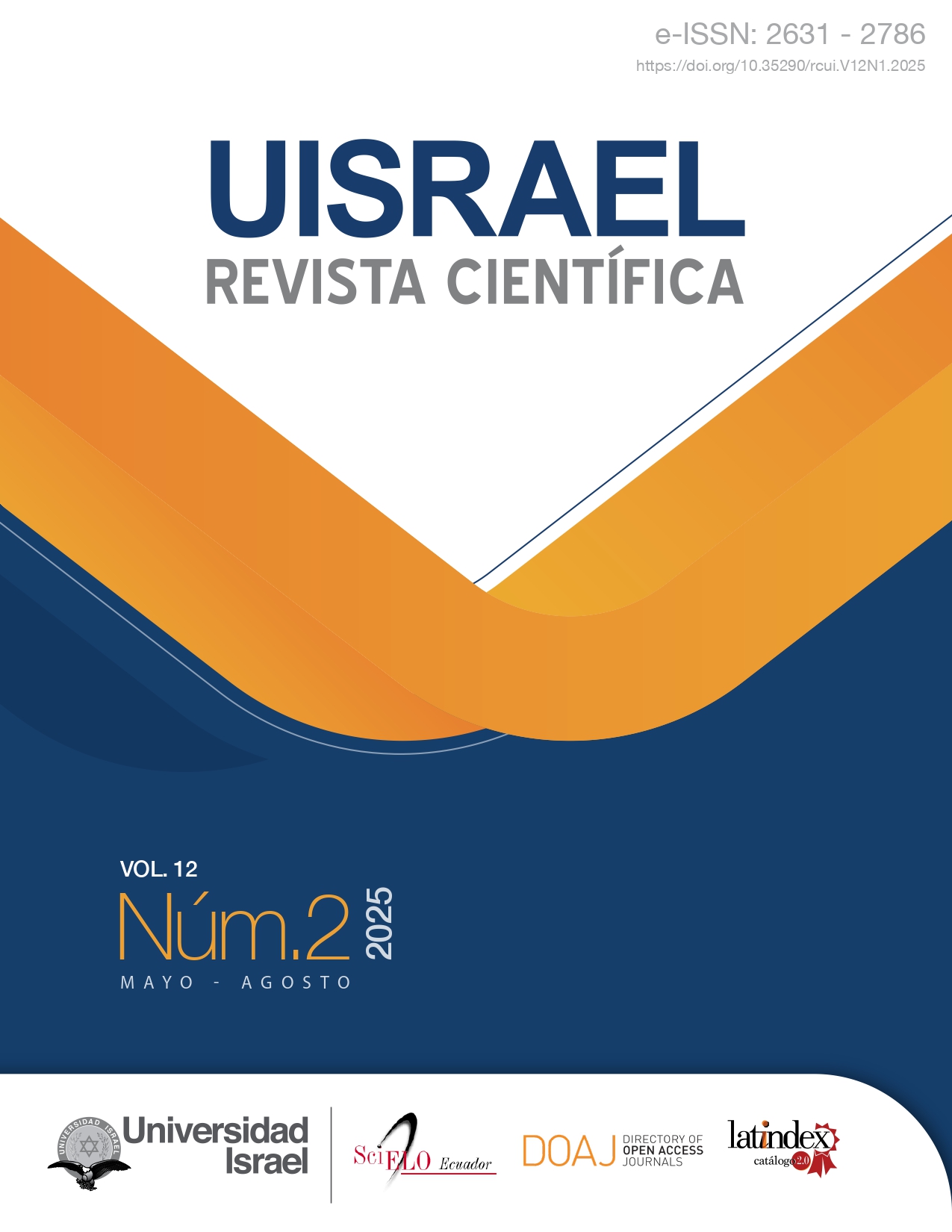Learning of areas with double integrals using GeoGebra: A study of master's students in mathematics education.
DOI:
https://doi.org/10.35290/rcui.v12n2.2025.1297Keywords:
areas, double integrals, GeoGebra, academic performanceAbstract
The main purpose of this research was to evaluate the impact of the teaching of area calculation through the use of Double Integrals using GeoGebra in students enrolled in the course of Geometric and Trigonometric Analysis within the Master's Degree in Education, mention in Mathematics Teaching, at the Universidad Técnica Particular de Loja. From this perspective, the research approach was framed in the positivist paradigm and adopted a quantitative approach of descriptive correlational character. The sample was selected from a population of 70 students, who were distributed in two groups, 35 students for the experimental group and 35 for the control group. A study sequence was implemented with the purpose of applying a dynamic geometric representation of the concept of Double Integral through the parameterization of curves and surfaces in GeoGebra, which allowed geometric visualization and calculation of generated areas. As a result, a significant improvement was observed in the geometric understanding of the Double Integral by the students with respect to the calculation of areas in flat regions.
Downloads
References
Arteaga, E. y Felipe, M. y Mendieta, J. y Martínez, J. (2019). El GeoGebra: una herramienta tecnológica para aprender matemática en la Secundaria Básica haciendo matemática. Revista Conrado, 15(70), 102–108. http://scielo.sld.cu/pdf/rc/v15n70/1990-8644-rc-15-70-102.pdf
Baena, D. (2020). RECURSOS DE GEOGEBRA PARA GEOMETRÍA EN EL ESPACIO [Universidad Politécnica de Madrid]. https://oa.upm.es/65698/1/TFM_DIEGO_BAENA_ALVAREZ.pdf
Borja, G. M. y Martínez, J. E. y Barreno, S. N. y Haro, O. F. (2021). Factores asociados al rendimiento académico: Un estudio de caso. Revista EDUCARE-UPEL-IPB-Segunda Nueva Etapa 2.0, 25(3), 54–77. https://doi.org/10.46498/reduipb.v25i3.1509 DOI: https://doi.org/10.46498/reduipb.v25i3.1509
Dahal, N. y Pant, B. P. y Shrestha, D. (2019). Integration of Geogebra in Teaching and Learning Geometric Transformation. Journal of Mathematics and Statistical Science, 5, 323–332. https://www.researchgate.net/publication/354776485
Duval, R. (2006). A Cognitive Analysis of Problems of Comprehension in a Learning of Mathematics. Educational Studies in Mathematics, 61(1), 103–131. https://doi.org/10.1007/s10649-006-0400-z DOI: https://doi.org/10.1007/s10649-006-0400-z
Guevara, G. P. y Verdesoto, A. E. y Castro, N. E. (2020). Metodologías de investigación educativa (descriptivas, experimentales, participativas, y de investigación-acción). Revista Científica Mundo de la Investigación y el Conocimiento, 4(3), 163–173. DOI: https://doi.org/10.26820/recimundo/4.(3).julio.2020.163-173
Hernández, R. y Fernández, C. y Baptista, P. (2014). Metodología de la Investigación (6a ed.). MacGraw Hill.
Hernández, R. y Mendoza, C. P. (2018). Metodología de la investigación : las rutas cuantitativa, cualitativa y mixta. McGRAW-HILL INTERAMERICANA EDITORES, S.A. de C. V.
Jiménez, J. G. y Jiménez, S. (2017). GeoGebra, una propuesta para innovar el proceso enseñanza-aprendizaje en matemáticas. Revista Electrónica sobre Tecnología, Educación y Sociedad, 4(7). https://www.ctes.org.mx/index.php/ctes/article/view/654/736
Miranda, S. y Ortiz, J. A. (2020). Los paradigmas de la investigación: un acercamiento teórico para reflexionar desde el campo de la investigación educativa. Revista Iberoamericana para la Investigación y el Desarrollo Educativo, 11(21). https://doi.org/10.23913/ride.v11i21.717 DOI: https://doi.org/10.23913/ride.v11i21.717
Pino, L. R. y Font, V. y Larios, V. y Gordillo, W. y Breda, A. (2018). Analysis of the meanings of the antiderivative used by students of the first engineering courses. International Journal of Science and Mathematics Education, 16(6), 1091–1113. https://doi.org/10.1007/s10763-017 DOI: https://doi.org/10.1007/s10763-017-9826-2
Purwanto, A. y Asbari, M. y Iman Santoso, T. y Sunarsi, D. y Ilham, D. (2021). Education Research Quantitative Analysis for Little Respondents: Comparing of Lisrel, Tetrad, GSCA, Amos, SmartPLS, WarpPLS, and SPSS. Jurnal Studi Guru dan Pembelajaran, 4, 335–351. https://doi.org/10.30605/jsgp.4.2.2021.1326 DOI: https://doi.org/10.30605/jsgp.4.2.2021.1326
Quintilla, M. y Fernández, A. (2021). Geogebra para la enseñanza de la geometría descriptiva: aplicación para la docencia online. 285–295. https://doi.org/10.5821/jida.2021.10545 DOI: https://doi.org/10.5821/jida.2021.10545
Svensson, K. y Campos, E. (2022). Comparison of two semiotic perspectives: How do students use representations in physics? Physical Review Physics Education Research, 18(2), 20120. https://doi.org/10.1103/PhysRevPhysEducRes.18.020120 DOI: https://doi.org/10.1103/PhysRevPhysEducRes.18.020120
Valmi, S. y Driessnack, M. y Costa, I. A. (2007). Revisión de diseños de investigación resaltantes para enfermería. Parte 1: diseños de investigación cuantitativa. Rev Latino, 15(3). www.eerp.usp.br/rlae
Zurita, J. N. y Márquez, H. y Miranda, G. y Villasís, M. Á. (2018). Experimental studies: Research designs for the evaluation of interventions in clinical settings. Revista Alergia Mexico, 65(2), 178–186. https://doi.org/10.29262/ram.v65i2.376 DOI: https://doi.org/10.29262/ram.v65i2.376
Downloads
Published
How to Cite
Issue
Section
License
Copyright (c) 2025 Marco Antonio Ayala Chauvin, Richard Leonardo Luna Romero

This work is licensed under a Creative Commons Attribution 4.0 International License.
Los autores que participen de los procesos de evaluación y publicación de sus ediciones conservan los derechos de autor y ceden a la revista el derecho a la primera publicación, tal como establecen las condiciones de reconocimiento en la licencia Creative Commons Reconocimiento 4.0 Internacional (CC BY), donde los autores autorizan el libre acceso a sus obras, permitiendo que los lectores copien, distribuyan y transmitan por diversos medios, garantizando una amplia difusión del conocimiento científico publicado.
- Toda derivación, a partir de esta obra, deberá citar la fuente y a la primera publicación en esta revista. Se permiten derechos comerciales no lucrativos sobre sus contenidos.
- Los autores pueden realizar otros acuerdos contractuales independientes y adicionales para la distribución no exclusiva de la versión del artículo publicado en esta revista, es decir, podrán incluirlo en un repositorio institucional o publicarlo en un libro, siempre que indiquen claramente que el trabajo se publicó por primera vez en esta revista.
- Se permite y recomienda a los autores compartir su trabajo en línea, con la finalidad de intercambios productivos para una mayor y más rápida citación del trabajo como lo establece los efectos del movimiento ‘Acceso Abierto’.
- No puede aplicar términos legales o medidas tecnológicas que restrinjan legalmente a otros de hacer cualquier cosa que permita la licencia: https://creativecommons.org/licenses/by/4.0/deed.es
- La Revista Científica es financiada completamente de los aportes realizados por nuestra entidad editora: Universidad Tecnológica Israel; por tal motivo, no establece cargos o cobros de ninguna índole a sus autores y colaboradores, así como tampoco genera pagos o remuneraciones de ningún tipo a ellos.
- Se asignará un Digital Object Identifier (DOI) a cada publicación.







